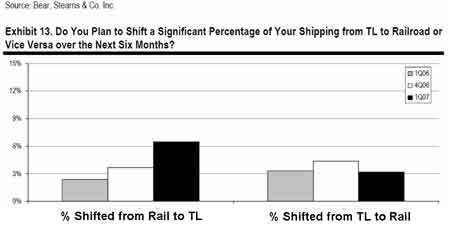SCDigest
Editorial Staff
The News: The
always interesting Bear Stearns quarterly
Shipper's Survey (called the Supply Chain
Indicator) was released earlier this month
for Q1 2007.
|
SC Digest Says: |
 Importers
are staying very focused on keeping
ocean container rate increases down
in the face of rising rail costs for
full international to domestic multi-modal
moves.
Importers
are staying very focused on keeping
ocean container rate increases down
in the face of rising rail costs for
full international to domestic multi-modal
moves.
What do you say?
Send
us your comments here |
The Impact: More
evidence that the “Perfect Transportation
Storm” of 2005 is largely gone for
now (but will be back, we expect), with
base rate increases down and capacity up
among most modes. Rail carriage remains
one exception, and then there are those
pesky fuel surcharges….
The Story: We
look forward every quarter to the release
of the Shipper’s Survey results from
investment firm Bear Stearns, under the
guidance of analyst Ed Wolf and several
colleagues. The result of survey input from
hundreds of shippers, the report provides
perhaps the most detailed view of what shippers
are thinking and doing of any report available
in the industry. (For the full report, go
to The
Bear Stearns Supply Chain Indicator Q1 2007).
The report
for Q1 2007, released earlier this month,
shows continued changes in the supply-demand
situation favorable to shippers, as slowing
demand plus rising capacity in the trucking
sector helps keep costs down.
Key findings
include:
- Shippers
see moderation in overall transportation
spending in 2007, with an average estimate
of just a 1-1.5% increase in rates across
all modes after the effect of rising volumes
is factored out. That’s down .5%
from a year ago.
- There
is still a “record setting”
perception of overcapacity in the truckload
market, giving shippers the edge. An amazing
80% of respondents believe there was overcapacity
in the TL market in Q1, the highest level
in the history of the survey. By comparison,
in the last major downturn for the trucking
industry in 2001-02, only 50-60% of respondents
saw overcapacity among truckload carriers.
- From the
capacity situation, shippers have mild
expectations for rate increases by TL
carriers in 2007. On average, shippers
expect just a 1.3% increases in TL rates
for 2007 before fuel surcharges, down
from 3% in the Q1 2006.
- There
are also strong perceptions of overcapacity
in the LTL market, and pricing expectations
for LTL carriers is the lowest since 2002.
Shippers expect 2007 LTL rate increases
of just 1.5%, down from 2.5% a year ago.
- Despite
the changing economics, shippers do not
see any impact yet on small carriers exiting
the market.
- Expectations
for rail pricing increases, however, remain
strong. Shippers expect 2007 increases
in rail rates to be 4% before fuel surcharges,
up from 3.5% in Q4 2006.
- The current
scenario is causing a greater percentage
of shippers which plan on moving freight
from rail to truck, citing both cost and
service issues. Interestingly, price has
actually replaced service concerns as
the number one reason for moving from
rail to truck. “Shippers expect
to move slightly more freight from rail
to truck and less from truck to rail than
we have seen in several years,”
the report says, noting this is counter
to the overall, longer term trend of increased
rail usage.
- A small
but growing level of shippers is beginning
to divert some freight from unionized
LTL carriers and UPS as we approach the
end of the union contracts for both, which
end March 31 and July 31, 2008, respectively,
over worries about a potential strike
and loss of capacity.
- Shippers
do not think “dimensional pricing”
is cost neutral, despite claims by UPS
and other parcel carriers. Respondents
believe the new rating programs, which
took effect in January, will actually
increase parcel shipping costs by 1.5%
based on cost per pound.
- Rate expectations
are also modest for ocean shipping, though
up slightly from last year. On average,
shippers expect ocean container increases
of 1.2% in 2007, but that’s up from
an expected decrease in rates in Q4 2006.
The report says it believes importers
are staying very focused on keeping ocean
container rate increases down in the face
of rising rail costs for full international
to domestic multi-modal moves. The implication
is that shippers will have more luck negotiating
on ocean container rates than with the
rail carriers.

A
Growing Number of Shippers Plan to Shift
Freight from Rail
to
Truck in the Short Term, though the Longer
Term Trend is the Opposite
What is your
reaction to the Bear Stearns Q1 shipper’s
report? Do you also see great overcapacity
in the TL and LTL markets? How long do you
expect that to last? Are changing dynamics
causing you to think about moving from rail
to truck? Let us know your thoughts at the
Feedback button below. |